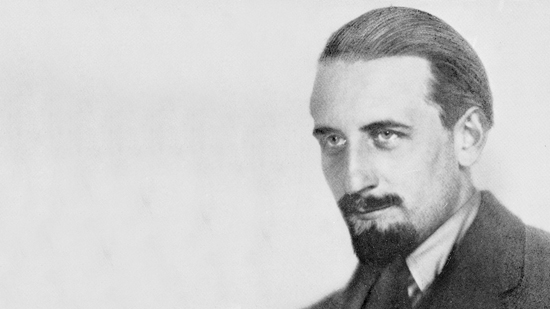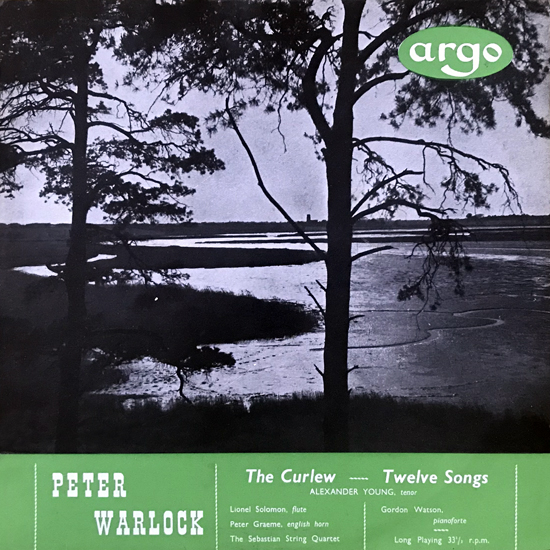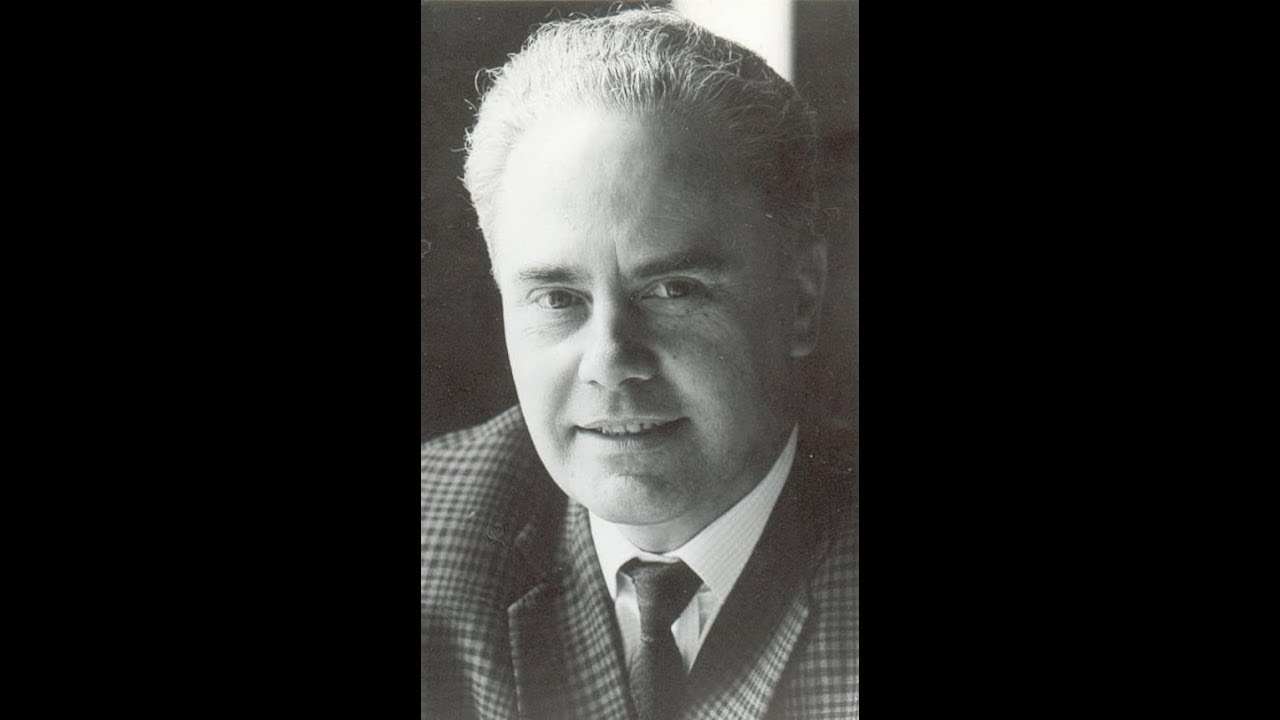There’s barely a more deathly read than the sleeve notes printed on the backs of classical records. On and on in miniscule type goes some dear old thing called Malcolm or Raymond, always more interested in compositional structure than the personal dramas and soap operas that inevitably led to the creation of the music within. The notes on this classical record from 1954 – a song cycle called The Curlew and 12 other tunes by British composer Peter Warlock – are different. Two paragraphs, ample intrigue.
The second paragraph quotes Warlock’s friend and biographer, Scottish composer and critic Cecil Gray: "The change from Philip Heseltine to Peter Warlock was a gradual one, involving several distinct and separate phases – firstly, the adoption of a pseudonym merely as a matter of practical convenience; secondly, its use as a kind of disguise and protective armour; thirdly, when it becomes positive and takes the offensive, as it were; and finally, a phase in which he takes a deliberate and perverse pleasure in turning upon and rending his former self and everything associated with him. The creation gradually assumes the upper hand over its creator, the monster over Frankenstein, and ultimately destroys him."
It’s a wonder that his music and story, which begins with him being born in the salubrious surroundings of London’s Savoy hotel in 1894 and ends with a presumed suicide at a rented flat in Chelsea aged 36, aren’t better known. There have been a couple of good biographies (Cecil Gray’s from 1934 and 1994’s Peter Warlock: The Life Of Philip Heseltine by a South African writer, Barry Smith), but no documentary or biopic (except a really bad TV movie, Some Little Joy, made in 2005 for about a tenner). Even one of his children, the famously acerbic art critic Brian Sewell, fobbed him off as a ‘minor composer’ in a Guardian article, possibly in anger. Sewell, born seven months after Warlock died, only found out who his father was in 2011, when his 96-year-old mother told him on her death bed. According to Sewell, she was "something of a prostitute, though perhaps that is too strong a word" and "one of his several mistresses". As for his father: "Sexually voracious, happiest with three in his bed – men or women. His tastes ran to sadism and were said to include flagellation. But the thing that appals me is that his remedy for pregnancy was abortion – without hesitation. He just waved a £5 note at my mother and told her to get on with it. The only thing I like about my father is that he took pains to put his young cat out before he turned the gas on. I will forgive him everything for that."
There’s more. Warlock, as his pseudonym suggests, studied the occult fanatically and it profoundly affected his views on music-making. (Inevitably, there are some – including Aleister Crowley – who believe that his demise came about as a consequence of his dabbling in black magic, and not because he was a manic depressive, probably bipolar and possibly, as some contemporary psychoanalysts believe, schizophrenic.) He loved to drink, might have been an alcoholic, smoked hashish for a short time, took magic mushrooms and maybe even cocaine. He was born into the establishment, went to Eton, then Oxford for a year, but he was a pacifist and a socialist, and he blamed Eton for turning him into a "moody, vindictive youth".
He could be spectacularly bitchy and childish. He knew the novelist D. H. Lawrence, who once lent him one of only two copies of a treatise he’d written about homosexuality, Goats And Compasses. After they fell out, rather than return the manuscript, Warlock used it as toilet paper, sheet by sheet. (Lawrence, for his part, unflatteringly based two minor characters in his 1920 novel Women In Love on Warlock and his wife, Puma. Warlock threatened libel, so Lawrence settled out of court, summing Warlock up in a letter as "that filthy rat".) Another time, Warlock was so annoyed that a man called Boris de Chrustchoff had married a woman he liked, although he’d introduced them, he waited until he was passed out on the street after a heavy session, then urinated on him. (The women in question, Phyl Crocker, later committed suicide, as did Puma, in 1943, after she’d remarried.) And, as a prolific writer about music as well as a composer, he loved to feud with other critics, especially in the pages of a magazine he briefly edited, The Sackbut, and particularly with one called Ernest Newman, about whom he penned this limerick:
Said a critic initialled E.N.:
‘Why does my wife like young men?’
A friend said: ‘You fool,
Don’t you know that the tool
Is mightier far than the pen?’
Yet, as the sleeve notes on this record also say, "His output contains some of the most beautiful songs in the English language," and even his enemies agreed. Despite their spat, Newman reviewed Warlock’s memorial concert at Wigmore Hall in London, saying: "The young man who could conceive these exquisite things [the songs ‘Corpus Christi’, ‘As Dew In April’, and ‘Balulalow’] and realise them so perfectly in music must have had the root of the matter in him; they are three gems that will keep his name alive as a composer."

There’s probably been no one like Peter Warlock in the history of British music, and he certainly got places by being a highly original personality. Somewhat leech-like, he would befriend and attach himself to better-known artists (the composer Frederick Delius, Lawrence, the painter Augustus John, Béla Bartók, whose music he helped introduce to the UK, and he also met W. B. Yeats), all of whom were deeply impressed by his savage wit, intellect and eventually his music, which took time to come to him. The epic and, at times, shockingly personal letters he wrote to Delius, beginning when he was a teenager at Eton, portray a hyper-sensitive person initially crippled by self-doubt, utterly unsure of his musical ability, and clearly searching for a father figure (his dad had died when he was three). Becoming Peter Warlock had a dash of showbusiness about it, but he also had a practical reason for adopting his nom de plume – or, more accurately, nom de guerre: Philip Heseltine had failed as a composer and, as a barbarous critic, unsuccessful concert promoter and piss artist on the scene in London, he’d also got up too many people’s noses. Peter Warlock was his way of starting again, although he was still only in his early-20s, and it worked a treat – the same publisher who had turned down songs written by Heseltine signed up Warlock, not knowing that the two men were one in the same.
Heseltine first used his pseudonym in 1916 and started to morph into Warlock a year later while avoiding possible conscription in Ireland (he was exempt on mental health grounds but had been summoned for a new medical examination as the war worsened). There, with Puma cruelly despatched to live in Wales with his mother, who was already bringing up their infant son, he had a series of intellectual and musical breakthroughs, largely inspired by his studies of the occult – a voguish pursuit at the time, shared by Lawrence, Delius and Yeats. He gorged on such cultish book as Éliphas Lévi’s History Of Transcendental Magic and The Apocalypse Unsealed by James Morgan Pryse, took part in séances and visited the medium Hester Dowden, also a musician.
Warlock’s fascination with black magic seemed to help unlock his unconscious mind, and with it his creativity. "Through his readings of a number of books on religion, the occult, and occult-related subjects, he was beginning to develop a more confident personal philosophy regarding music and creative inspiration – a philosophy which hints at a kind of automatic writing," wrote Barry Smith in his biography. "Mere technical equipment was not enough: the composer is the vessel into which a higher force pours the finished product – if the recipient is open to this flow. As he eventually summed it up: ‘All art that is of real value must be the overflow, and not merely the fullness, of life. Music is the voice of the God in man.’"
In essence, he was trying to free himself of the strictures of musical education and open himself up to inspiration, or the "spirit of music". He began to think of the professional composer as the enemy of music, intellect as a "clogging impediment", and technique as "no one thing", adding, "If one has something to say, IT will GET ITSELF said, sooner or later, whether one be mad or sane, willing or unwilling, conscious or unconscious… How a thing is done is absolutely unimportant – what matters is to get it done." The musical establishment ridiculed him, but he didn’t care. He now seems ahead of the curve (popular forms, from jazz to punk, enshrined similar values as gospel), and he demanded a revolution from listeners, too: "If people would only listen to [classical] music without being obsessed with the notion that they won’t understand it unless they are ‘educated up to it’, they would be surprised at the ease with which they understood it and the increase of pleasure they derived from it."
Warlock’s breakthroughs didn’t come easily. In Ireland, he suffered acute bouts of anxiety, paranoia and depression – possibly exacerbated by his experiments in black magic – but he nonetheless began to write songs now considered to be miniature masterpieces. He was a changed man, and it showed in his appearance, too. When he returned to London on a hot August morning in 1918, he was met at the station by Cecil Gray, who described him in his biography as "wearing a thick fur coat with the collar turned up, a large sinister black hat, with the brim turned down, dark spectacles and a huge unkempt beard, which, though real, looked as if it were false. He looked, in fact, liked an exaggerated caricature of a Bolshevik and a German spy combined."
The first half of this record is taken up by The Curlew, written between 1920 and 1922, and the work that made Warlock’s name. He described it as a "kind of symphonic poem", which says something of its structure. It’s four different settings of poems by Yeats, but there are no breaks between the songs (sung here by the tenor Alexander Young), just instrumental interludes. The music is played by a simple set-up – a string quartet with a flute and a cor anglais (English horn) – and it’s the latter instrument that helps give the suite such an eerie, melancholy feel. "With constant awareness of the changing moods of Yeats’s poetry, Philip’s setting employs sensitive and subtle word-painting," Barry Smith wrote. "Nowhere does Philip bare his tormented soul more openly than in this cri de cœur which lasts a little under twenty-five minutes.” Gray described the feel of the piece as “one of the darkest despair… I do not know of any music, in fact, more utterly desolating to hear."
Warlock was an expert on old British songs, particularly Elizabethan ones, and The Curlew is influenced by folk traditions. He was also a modernist, and this work is equally inspired by Béla Bartók – a Hungarian who similarly incorporated folk music into his compositions – and the charismatic Dutch composer Bernard van Dieren, who Warlock considered to be "the greatest artist of his generation". It seems straight-forward but it’s inventive and clever, and Warlock naturally feared it would be rubbished, or misunderstood: "It sounds like depths of isolation and despair, so of course people don’t take it seriously but speak of pose and the ‘luxuriousness’ of Celtic melancholy," he wrote. "I know my limitations and keep within them, and where people will class me among my blasted English contemporaries, for none of whom do I care one three-farthing fuck, is no matter at all." But, in a rare moment of self-praise, he also said: "I think this it is by far the best work I have done yet."
The b-side here is made up of dozen astonishingly good, short songs – including two of his most-loved ones, ‘Sleep’ and ‘The Fox’ – but, for my money, the other great work that Warlock produced was a suite of six Renaissance-era dances, Capriole, written when he lived in Eynsford, Kent between 1925 and 1928, sharing a cottage with the composer Ernest John Moeran and a Māori factotum called Hal Collins, dead from tuberculosis before the decade was through. And it’s those three years that provide us with the most extravagant examples of Warlock’s outrageous behaviour – of how he would get so shit-faced that he couldn’t even make it to the pub across the road (the barmaid would bring pints over); drive his motorcycle naked through the country lanes; and host orgies, possibly with sadomasochist overtones (there are reports of the sounds of whips and what-not being heard from street, which may not be true, although Warlock was certainly a "sex crank", as the sister of his first girlfriend called him).
The sheer number of friends and colleagues from the London art world that Warlock invited to stay with him in Eynsford led to these tales being reproduced in books, doubtlessly exaggerated. Less well reported is quite how industrious he was during his three years there. He raised hell at the weekends, worked studiously during the week, hoping, as he did throughout his short life, to achieve the respectability of making a living as a composer. He never managed that and left Kent broke, to go and live with his overbearing, but supportive – financially, at least – mother. "I can no longer sell even the exiguous amount of trash and drivel that I have hitherto been turning out – sullying the name of music in the process," he wrote.
Warlock didn’t last long at his mother’s. He spent his last years in London, desperately searching for work. He conducted Capriol at the Proms, picked up occasional music journalism work and sold some songs, but the impact of the Wall Street Crash and advent of broadcasting and gramophone records severely affected his fortunes. "The market for solo songs had slowly begun to disappear and he was having difficulty selling what songs he had been able to compose," wrote Barry Smith, suggesting he had all but dried up as a musician. He might also have been losing his mind. Of all the crack-pots schemes he came up with for making money in his final years, none was more perplexing than a plan to buy, as Cecil Gray wrote, "a certain piece of ground somewhere in Kent or Sussex where there are certain caves which he proposed to furnish and let at high rents to flagellants, who could pursue their pleasures without disturbing neighbours by screams and groans, and without arousing the undesirable attention of the authorities".
It was in the 1930s that Gray said Peter Warlock "gradually assumes the upper hand over its creator, the monster over Frankenstein, and ultimately destroys him", which, in retrospect, reads like an absurdly melodramatic misunderstanding of bipolar disorder. To a girlfriend at the end of his life, Winnifred Baker, Warlock addressed a kind duality of personality within himself, but in terms that are far more subtle and desperate. "Try imagining a man who has killed himself, but finds that somewhere he is still conscious; somewhere unfathomably remote," he wrote. "He can still see the people he loved, the places he knew, but at an unimaginable distance."
Warlock spent his adult life promoting with a fervour bordering on obsession the music of the composer he considered to be "the greatest artist of his generation", Bernard van Dieren, a close friend. He penned great essays about his significance, put on concerts of his works, shared what money he had with him (although it’s thought that he was a morphine addict) and, in 1920, made him the sole beneficiary in his will. Along with his wife Frida, van Dieren was the last person to see Warlock alive. The three had met in a pub, moved on to Warlock’s flat, then the van Dierans left, only for Warlock to be found dead early the next morning, poisoned by coal-gas. Unsure whether the death was an accident or suicide, the coroner recorded an open verdict and, much later, another scenario emerged, posited by the son Warlock had with Puma, Nigel – that his father had been murdered, and van Dieran was to blame.
Curiously, Warlock had written a new draft of his will on that last night, leaving what he had to Winnifred Baker. We don’t know why, nor whether van Dieran knew he was the beneficiary of the original will, but no Warlock scholar believes he was murdered, or that his death was an accident. At 36 in 1930, Warlock took his own life, to the shock of the music world. The obituaries were generous, particularly van Dieran’s in the Musical Times: "Can one give higher praise? If I knew how to, I would do it. But if genuine emotion, infinite charm, and grace, can preserve a spirit as a living reality for future generations, the tribute of my admiration is unneeded. Much of ‘Warlock’s’ music will have become a national treasure when all that was ever said or written about it today will be forgotten."
Warlock would have been pleased to hear that from a man he so admired. Or he might have scoffed. While living in Kent, he’d written his own epitaph as a limerick and it went like this:
Here lies Warlock the composer
Who lived next door to Munn the grocer.
He died of drink and copulation,
A sad discredit to the nation.



